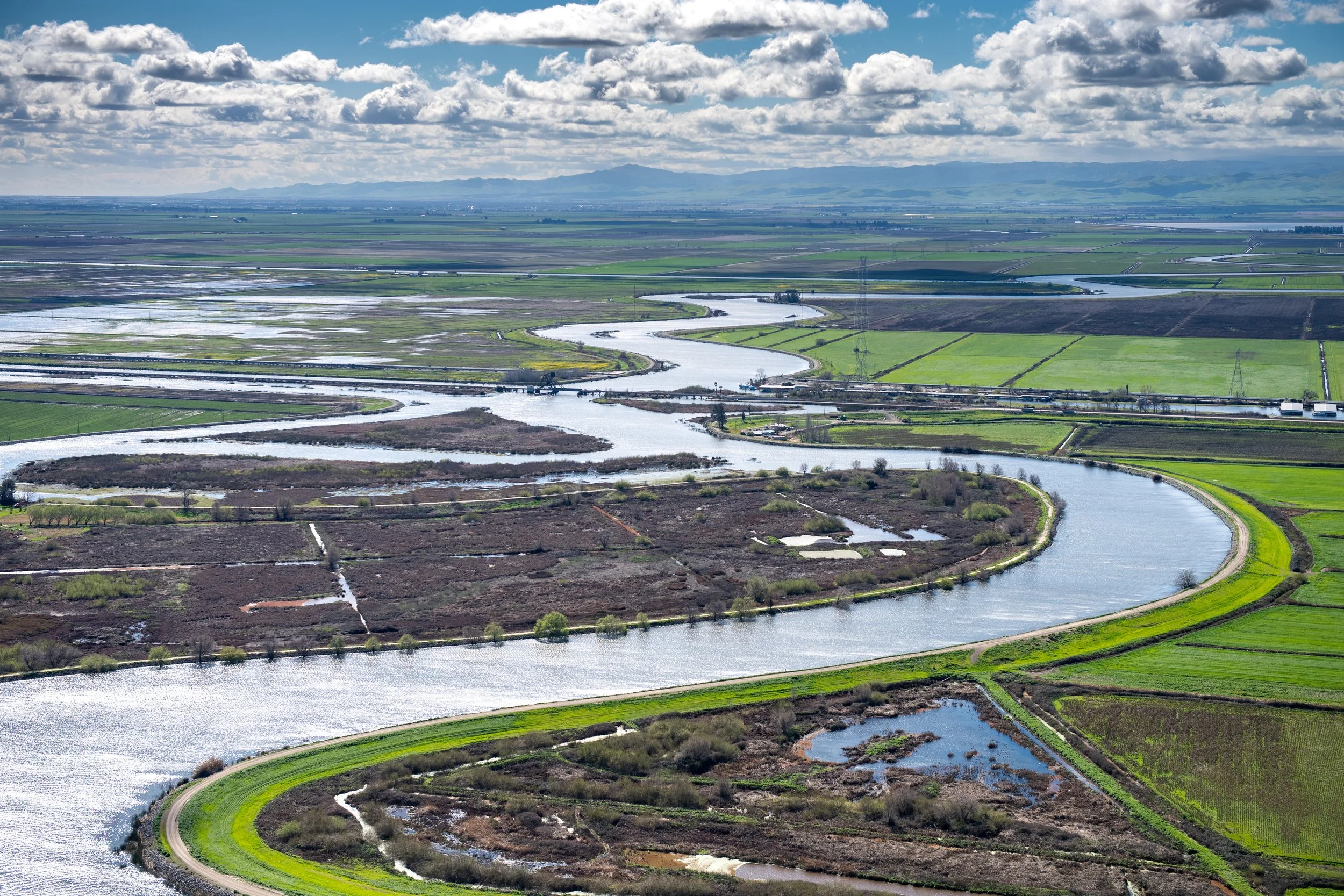The Bay-Delta Plan Staff Report and the Real “Healthy Rivers Alternative”
Aerial view looking south along Old River, in the center is Fay Island, part of the Sacramento-San Joaquin River Delta in San Joaquin County. March 08, 2019. Credit: Ken Jones, CA Dept. Water Resources.
The California State Water Resources Control Board (Water Board or Board) recently released its Draft Staff Report for the Phase II Update of the Bay-Delta Water Quality Control Plan (Bay-Delta Plan or Plan). This report, and the process to update the Bay-Delta Plan, will have critical implications for the health of California rivers and ecosystems. Unfortunately, the Staff Report outlines several options that will fail to protect the Delta and its tributary rivers. Instead, the proposals, or “alternatives,” include flows that are not sufficient according to science. One of these flow schemes is the Voluntary Agreements (VAs), which is a package of habitat restoration and flow measures proposed by the state’s largest water users.
The Plan Update is long overdue. The federal Clean Water Act and California Porter-Cologne Act require the Board to undertake triennial reviews of the Plan and to update water quality standards to ensure the protection of beneficial uses. However, the Plan has not been updated since 2009, and the flow and water quality standards have not been meaningfully changed for nearly 30 years (1995). The Bay-Delta Plan is one of the state’s strongest mechanisms to protect aquatic ecosystems and the endangered species that rely on them. The updated Plan could be a lifeline for the Delta and California’s rivers.
O’Neill Forebay, part of the California Aqueduct, which pumps water from the Delta for use in Southern California. Credit: CA Dept. of Water Resources.
In the interim, conditions in the Delta continue to degrade. Native species are declining, and some, including Delta smelt and Chinook salmon, are plummeting toward extinction. The Delta smelt hasn’t been caught in the California Department of Fish and Wildlife’s Fall Midwater Trawl since 2015. And, the entire Chinook salmon fishery in California was closed for the 2023 season. Toxic algae outbreaks are choking fish, killing dogs, and having profound public health impacts. Adequate flow can remedy these issues and more. Water that flows through the Delta to the ocean is essential for many uses, including salinity control for drinking water and farming, wastewater treatment, endangered species support, sediment transport to replenish beaches and marshes (reducing impacts from sea-level rise and creating habitat), and to flush out toxic algae blooms.
The controversial VAs, which themselves have delayed the Plan update, would exacerbate these issues, not resolve them. As proposed, the VAs provide a modest flow increase coupled with increased habitat, effectively trading flow for scientifically unsupported habitat restoration. As an example, the Yuba River is being used as an exemplar for the VAs. However, despite recent habitat restoration work, Yuba salmon are not recovering from population collapse(2). Further, the VAs have been branded as a collaborative solution. However, they were developed in closed-door negotiations that excluded conservation organizations, tribes, and impacted communities – the very populations with the right combination of incentives and expertise to provide meaningful recommendations and feedback. The Voluntary Agreements are a threat to California’s rivers.
Sandhill cranes forage near Woodbridge Rd. in Lodi, California. The season begins with the arrival of the sandhill cranes into the Sacramento - San Joaquin Delta and Central Valley in about late September, where they will spend the fall and winter months. January 25, 2019. Credit: Florence Low, CA Dept. of Water Resources.
Adequate flow standards will not only protect the Delta, but will extend to all the major rivers that empty into the Delta. In other words, Delta flow standards can improve conditions in many of California’s major rivers by requiring healthy flows from them. Rivers need water.
The Water Board is under extreme political pressure to approve the VAs or some other weak version of the Bay-Delta Plan. Doing so would continue the status-quo over-consumption of California’s water resources, which is heavily driven by unsustainable agricultural practices such as expansion onto unsuitable soils, and the recent dominance of thirsty cash crops. The Delta ecosystem is at a breaking point, and the status quo will not reverse course.
However, the Water Board has the authority to halt this decline and resuscitate the Delta. It has an opportunity to correct historic overconsumption by exercising its authority to prescribe increased flow and non-flow measures such as habitat restoration. Doing so will require extreme bravery, but our rivers and communities are counting on it.
The water buffalos are falsely calling the VAs the “Healthy Rivers and Landscapes Alternative.” The real “healthy rivers alternative” is restoring flows through the Delta and its tributary rivers.



